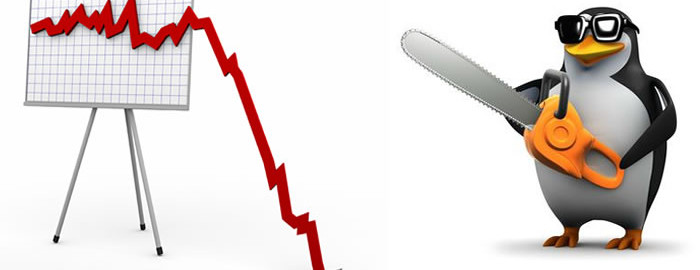What to do when your search rankings plummet
In the last couple of weeks we’ve had a flurry of enquiries from businesses that have had dramatic falls in their search engine rankings. Some of these businesses were previously at #1 or #2 on Google for important keywords, but now are nowhere to be seen.
The impacts on the businesses are severe – in most cases the number of enquiries has plummeted and subsequent sales have followed suit. Understandably, they are very worried and need help to fix the problem, fast.
What went wrong?
The first thing we try to do is work out what went wrong. We ask them a bunch of questions – have you previously engaged an SEO firm or consultant? Did you do link building? When exactly did the rankings plummet?
In most cases, the answers are yes, yes, and one of a few key dates from 2012 or 2013. Why is this significant?
Enter The Penguin
On April 24, 2012, Google released a major update to its algorithm (the secret formula that determines web rankings) called ‘Penguin’. This update was primarily aimed at improving the quality of search results by demoting sites that had boosted their results by creating large numbers of links pointing back to their site.
It also targeted ‘over-optimisation’ of websites – the stuffing of keywords into title tags, headings, copy etc in an attempt to improve rankings.
Many websites saw dramatic falls in their rankings around that date, however more was to come.
On May 22, 2013, Penguin 2.0 was rolled out, hitting many more sites that had used link-building targeted at internal pages of their sites (Penguin 1.0 mainly focused on links pointing to the home page). Many other minor updates were also released, fine tuning the algorithm and having effects of their own.
Were you affected?
Do you know if your site was impacted by these updates? If you’ve never had backlinks created for you by an SEO company, or never had your site (badly) optimised, you should be fine. If you have, then a check of your search ranking history should tell you if you were impacted. Hopefully your SEO company has been providing monthly ranking reports for you. Take a look at these and see if there were drops in your rankings during those key periods in April/May 2012 and May-June 2013.
Help! Penguin!!
If your rankings plummeted around those dates, it’s highly likely you were impacted by Google’s Penguin update. The penalty applied by Google could be a manual penalty, where your site has been singled out for its SEO practices and manually penalised (you can see if this has happened within your Webmaster Tools account). You’ll need to take the below actions then submit a Reconsideration Request.
More likely is an ‘algorithmic penalty’ where your rankings were automatically demoted by Google based on your poor link profile or over optimisation.
The first thing to do is talk to your SEO company about it. If they’re worth their salt, they’ll acknowledge the issue and come up with a plan to rectify the situation. However, if they are not able to do that or are no longer on the scene, you’ll need to take action yourself, or find a company that can help.
What to do next
The bottom line is that to recover your rankings you need to remove the links that are causing the problem. This, of course, is easier said than done. This article gives a detailed run-down of how to tackle link removal, but below we’ve outlined the basic steps. It’s not for the faint-hearted though, and unless you’re already very SEO-savvy, it’s an area that may be best left to the professionals.
- Analyse your backlinks – Google’s free Webmaster Tools gives you a good way to see many of the links that point to your site. However, a full link audit paid tool like Majestic SEO will give you the detailed picture you’ll need to work through all your links and identify the problem ones.
- Identify the problem links – If you’ve got a whole heap of links that use the same anchor text (the words used within the link itself) full of your keywords, and they are on sites with no relation to the topic, they are likely to be suspect. Google likes to see a natural spread of links using your URL, your company name, terms like ‘click here’ or ‘read the article’ as well as keyw0rd-rich links. If you have too many of the latter, it appears un-natural and you could be penalised. (more on natural link profiles here)
- Remove the problem links – This is the hardest part. Often the only way to remove a link is to ask the webmaster on the site to do it. When there are thousands of these links, it’s no small task. It’s often something that can be outsourced – the labour intensive task of getting contact details and sending off hundreds of emails can be done by specialist agencies or freelancers (try Freelancer.com). Again, talk to your SEO company to see what they can do here. This article covers this area in more detail.
- After the exhaustive link removal process where you’ve removed all detrimental links that can possibly be removed, you can use Google’s Disavow Tool to tell the search engine that you’ve done your best and you would like the remaining links to be ‘disavowed’, or not taken into consideration.
The outlook for recovery
Depending on the scale of the problem and the competitiveness of your industry, there are three scenarios:
- Complete recovery to your former glory
- Partial recovery with lower rankings
- Permanent dismal rankings
In the last case, a new site with a new URL may be the best solution, especially if your old domain has only been around a year or two. Recovering from a Google Penguin penalty is a long and arduous process – well worth it if you have a strong URL with a long history, but sometimes it is better to cut your losses.
Get advice
This article really only scratches the surface of this complex topic. Search ranking is an area that can make or break a business, so our advice is to get advice. A reputable web optimisation company or consultant should be able to do a thorough website and link audit for you to give you a clear picture of the issues and outlook for recovery.
If you think that your site has been impacted by the Penguin, we’d like to help. Send us an email with your site address and some background info and we’ll give you a quick appraisal. If a Google penalty is suspected we’ll recommend a site and backlink audit to confirm it.
The cost of such an audit depends on the site itself, but for most SME websites around $500 will cover a detailed audit for the purposes of identifying the cause of a ranking penalty. If your website is an important source of leads and sales for your business it could be the best $500 you ever spend.





